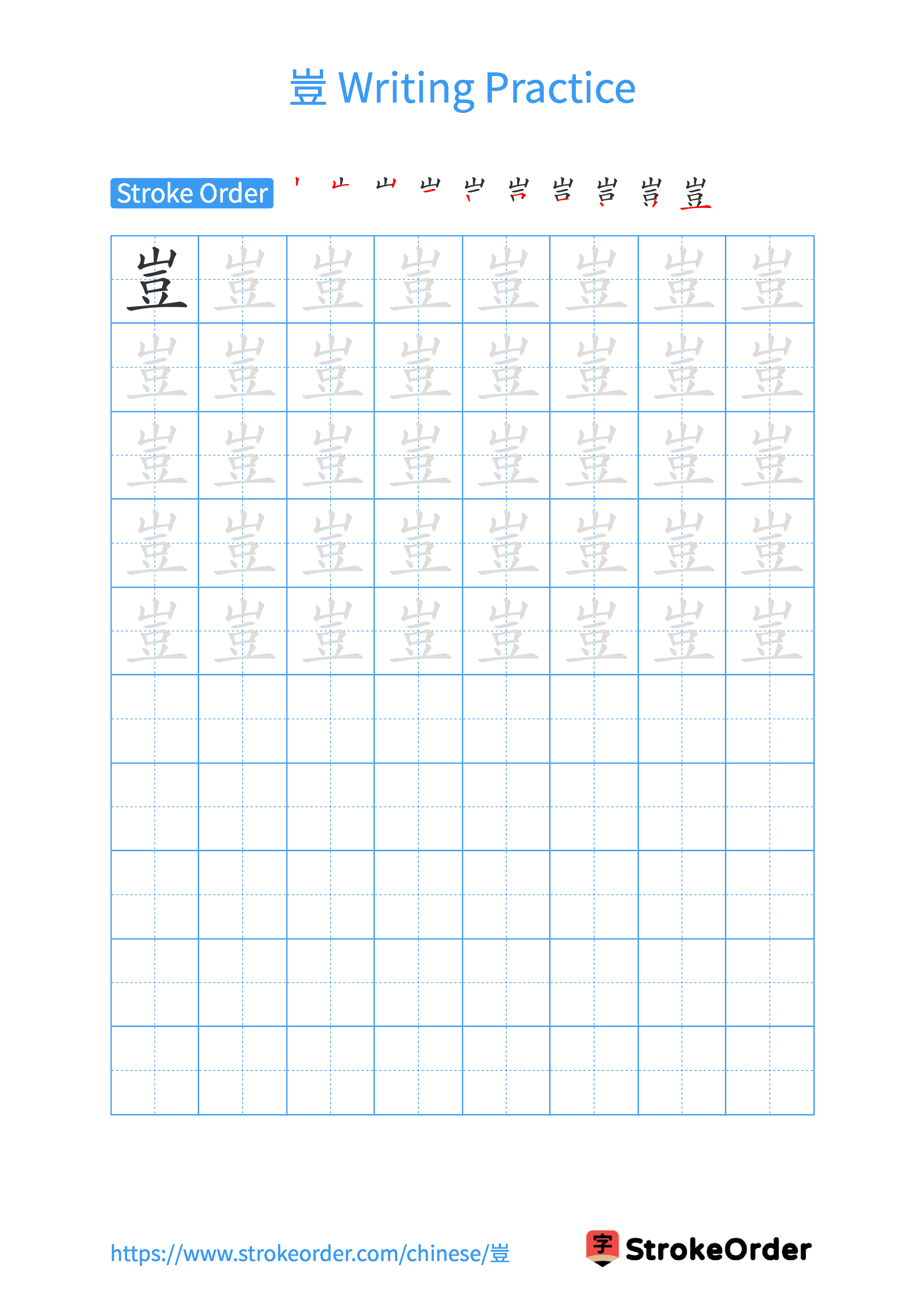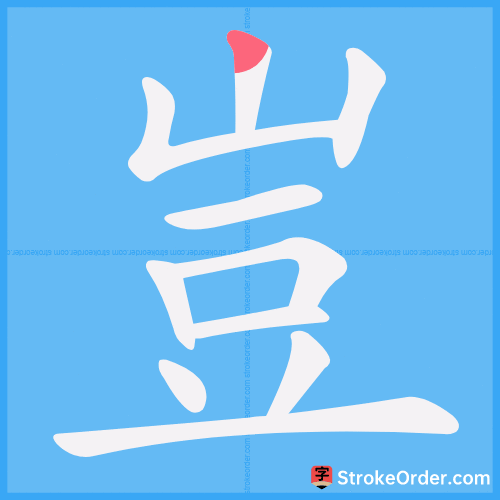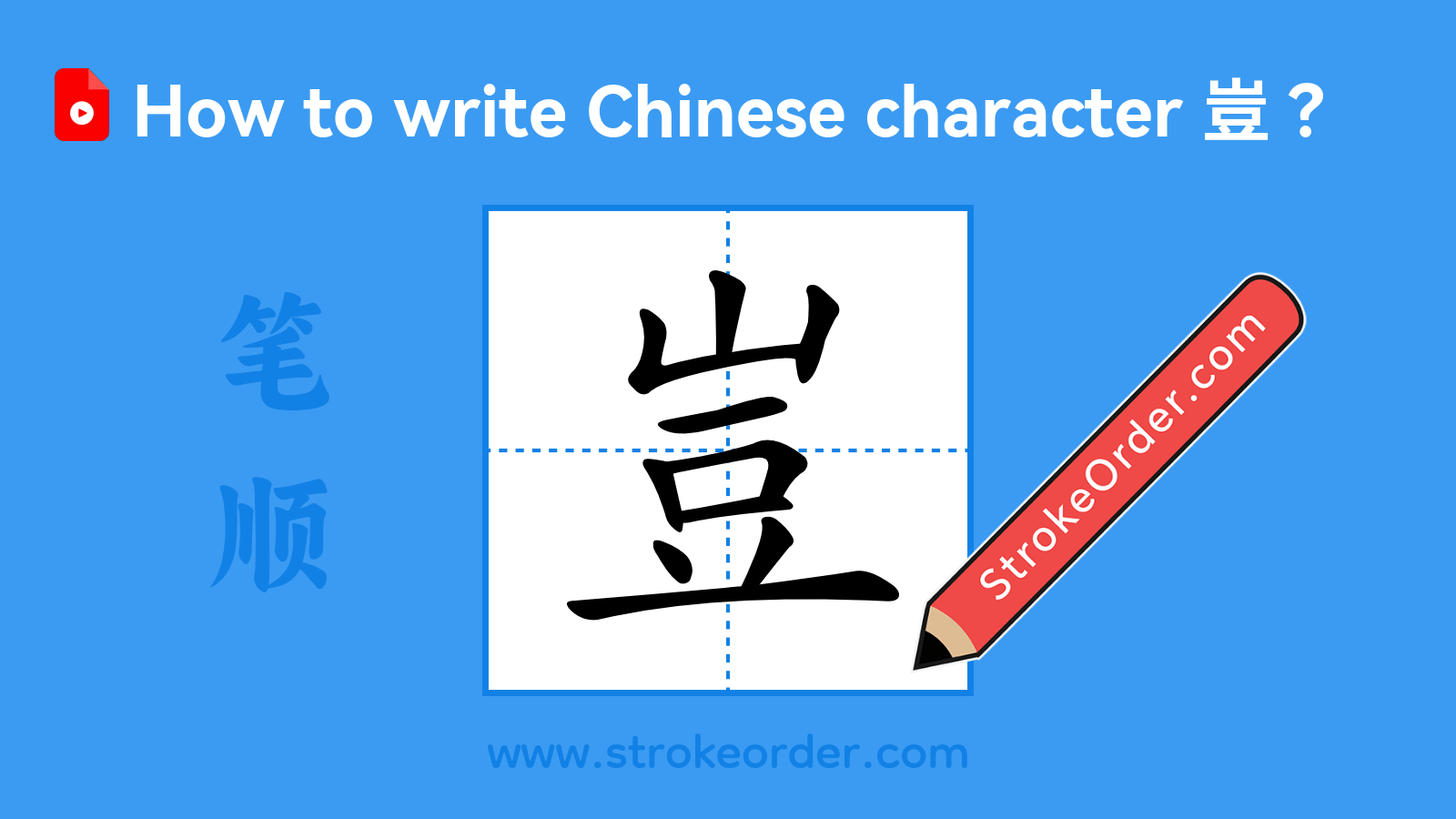豈 Stroke Order
Animated Stroke Order of 豈
Stroke Order Diagrams for 豈
Step-by-Step Handwriting Guide for 豈
Learn to Write Chinese Characters with Video Tutorials
Watch the video of writing the Chinese character "豈", learn the correct stroke order (笔顺) of the character "豈", and master the standard way of writing the character "豈".
Free Printable Handwriting Practice with Stroke Order: 豈
Printable Writing Practice Worksheet of "豈" in Portrait Orientation (Tian Zi Ge)

Printable Writing Practice Worksheet of "豈" in Landscape Orientation (Tian Zi Ge)

Information of 豈
Pinyinqǐ、 kǎi
Radical
豆
Strokes
10 strokes
Usage
★★★
Definition
how can it be that
豈 qǐ 1. A particle used to indicate rhetorical questioning (e.g., "how could", "how could it be", "is it possible that"). For example: "豈敢" (How dare), "豈堪" (How could one bear), "豈可" (How could it be allowed), "豈有此理" (Is there such a reason?).2. It expresses surprise or incredulity, equivalent to "難道" (is it possible that), "怎麼" (how). 3. It indicates an additional consideration, equivalent to "何況" (much less; let alone).4. It denotes an alternative, meaning "其" (its). 5. It expresses a wish or command, indicating an imperative mood (e.g., "would"). 6. It denotes estimation or conjecture, equivalent to "也許" (perhaps) or "莫非" (maybe). Example: 荊卿豈無意哉。(Isn't Jingqing intentional?) 豈 qǐ 形 (adjective): Same as "愷" (kǎi). Comfortable; joyful. 引: 1. 《詩·小雅·魚藻》: "The king is in the Hao, how can one enjoy drinking?" 2. 《詩·小雅·蓼蕭》: "Upon seeing the gentleman, how could Kong Yan feel joy?" 副 (adverb): 1. "豈" is used as a grammatical particle, effective at the start or in the middle of a sentence, indicating a rhetorical question. Examples: 1. 《戰國策·趙策》: "Is it not a long-term plan?" 2. Tang Dynasty - Liu Zongyuan, "Is it not better than our neighboring area?" 3. Ming Dynasty - Liu Ji, "Is it because of the frustration with the world?" 4. Ming Dynasty - Liu Ji, "Is it only one qin?" 2. It is equivalent to "何況" (much less; let alone). Example: "豈況" (let alone). 3. It is indicative of "其". 4. It expresses a command or desire (e.g., "豈不可" - how can it not be allowed?). 5. It denotes estimation or speculation, equivalent to "也許" (maybe). 引: 1. 《戰國策·燕策》: "Is it possible for the general to have intentions?" 2. "Is Jiangqing not intentional?" 3. "Would the general wish to meet?" 例: 又如: 豈有 (perhaps there is). 1. Same as "愷", meaning joy. 2. Same as "凱", meaning victorious. Noun: The musical piece played when troops return in triumph. According to "說文解字," it refers to "豈," the celebratory music for the victorious return of an army. Adjective: Harmonious and joyful, analogous to "恺" and "凯." Examples include: 《詩經·小雅·魚藻》: "The king at Hao, how can one enjoy drinking?" In the poetry of the Three Kingdoms, Wei - Yuan Ji: "How could one enjoy in the spirit tower, drifting high and far?"
Input Method for 豈
Pinyinqi3
Wubi
mnb
Cangjie
usu
Zhengma
llyy
Four Corner
22717
Unicode
U+8c48
Same Pronunciation Characters
乞企其凄启奇契妻岂崎弃戚旗期柒栖棋欺歧气汽泣漆砌祈脐起迄骑鳍齐七亓
Same Radical Characters
豆豌豇豉豈豊豎豐豔豍豋豏豓豑豒䜼䝁䝀䜸䝄䜶䜽䝃䜿䝂䜳䜷䜾䜵䜹䜻䜺
本文来自人间香奈儿投稿,不代表汉字笔顺中文网英文版立场,如若转载,请注明出处:https://www.strokeorder.cn/strokeorder/24975.html





 微信扫一扫
微信扫一扫 